The Susceptibility of Wetland Areas in the Yangtze River Basin to Temperature and Vegetation Changes
Abstract
1. Introduction
2. Materials and Method
2.1. Study Area
2.2. Materials
2.2.1. Land Cover Products
2.2.2. Climatic Scenarios and Environmental Predictors
2.3. Methods
2.3.1. Wetland Distribution Modeling
- The weak classifier trains a model and assigns weights w to each variable I proportional to the probability associated with the classification of each variable in the model.
- The weighted sum of the classification rate E is expressed bywhere errori is the calculated error for each case i and wi is the weight for assigned by the classifier for each case.
- The weight of each case is updated, proportional to the error of each case if the case was classified incorrectly, otherwise the weight is unchanged.
2.3.2. Accuracy Assessment
2.3.3. Sensitivity Analysis
3. Results
3.1. Wetland Simulation
3.2. Future Changes of Potential Wetland
3.3. Environmental Variables Sensitivity
4. Discussion
4.1. Model Performance and Influencing Factors
4.2. Future Wetland Change and Its Sensitivity
5. Conclusions
Author Contributions
Funding
Data Availability Statement
Acknowledgments
Conflicts of Interest
References
- Yang, W.; Zhong, J.; Xia, Y.; Hu, Q.; Fang, C.; Cong, M.; Yao, B.; You, Q. A Comprehensive Multi-Metric Index for Health Assessment of the Poyang Lake Wetland. Remote Sens. 2023, 15, 4061. [Google Scholar] [CrossRef]
- Niu, Z.; Gong, P.; Cheng, X.; Guo, J.; Wang, L.; Huang, H.; Shen, S.; Wu, Y.; Wang, X.; Wang, X.; et al. Geographical characteristics of China’s wetlands derived from remotely sensed data. Sci. China Ser. D Earth Sci. 2009, 52, 723–738. [Google Scholar] [CrossRef]
- Peng, S.; Lin, X.; Thompson, R.L.; Xi, Y.; Liu, G.; Hauglustaine, D.; Lan, X.; Poulter, B.; Ramonet, M.; Saunois, M.; et al. Wetland emission and atmospheric sink changes explain methane growth in 2020. Nature 2022, 612, 477–482. [Google Scholar] [CrossRef] [PubMed]
- Fluet-Chouinard, E.; Stocker, B.D.; Zhang, Z.; Malhotra, A.; Melton, J.R.; Poulter, B.; Kaplan, J.O.; Goldewijk, K.K.; Siebert, S.; Minayeva, T.; et al. Extensive global wetland loss over the past three centuries. Nature 2023, 614, 281–286. [Google Scholar] [CrossRef] [PubMed]
- Mahdian, M.; Hosseinzadeh, M.; Siadatmousavi, S.M.; Chalipa, Z.; Delavar, M.; Guo, M.; Abolfathi, S.; Noori, R. Modelling impacts of climate change and anthropogenic activities on inflows and sediment loads of wetlands: Case study of the Anzali wetland. Sci. Rep. 2023, 13, 5399. [Google Scholar] [CrossRef]
- Davidson, N.C.; Finlayson, C.M. Extent, regional distribution and changes in area of different classes of wetland. Mar. Freshw. Res. 2018, 69, 1525–1533. [Google Scholar] [CrossRef]
- Dixon, M.J.R.; Loh, J.; Davidson, N.C.; Beltrame, C.; Freeman, R.; Walpole, M. Tracking global change in ecosystem area: The Wetland Extent Trends index. Biol. Conserv. 2016, 193, 27–35. [Google Scholar] [CrossRef]
- Niu, Z.; Zhang, H.; Wang, X.; Yao, W.; Zhou, D.; Zhao, K.; Zhao, H.; Li, N.; Huang, H.; Li, C.; et al. Mapping wetland changes in China between 1978 and 2008. Chin. Sci. Bull. 2012, 57, 2813–2823. [Google Scholar] [CrossRef]
- Luan, Z.; Zhou, D. Impacts of intensified agriculture developments on marsh wetlands. Sci. World J. 2013, 2013, 409–439. [Google Scholar] [CrossRef]
- Hu, S.; Niu, Z.; Chen, Y.; Li, L.; Zhang, H. Global wetlands: Potential distribution, wetland loss, and status. Sci. Total Environ. 2017, 586, 319–327. [Google Scholar] [CrossRef]
- Chen, Z.; Yu, L.; Gupta, A. The Yangtze River: An introduction. Geomorphology 2001, 41, 73–75. [Google Scholar] [CrossRef]
- Li, X.; Yu, X.; Jiang, L.; Li, W.; Liu, Y.; Hou, X. How important are the wetlands in the middle-lower Yangtze River region: An ecosystem service valuation approach. Ecosyst. Serv. 2014, 10, 54–60. [Google Scholar] [CrossRef]
- Huang, B.; Ouyang, Z.; Zheng, H.; Zhang, H.; Wang, X. Construction of an eco-island: A case study of Chongming Island, China. Ocean Coast. Manag. 2008, 51, 575–588. [Google Scholar] [CrossRef]
- Liu, Y.; Zhang, X.; Kong, X.; Wang, R.; Chen, L. Identifying the relationship between urban land expansion and human activities in the Yangtze River Economic Belt, China. Appl. Geogr. 2018, 94, 163–177. [Google Scholar] [CrossRef]
- Mao, D.; Wang, Z.; Wu, J.; Wu, B.; Zeng, Y.; Song, K.; Yi, K.; Luo, L. China’s wetlands loss to urban expansion. Land Degrad. Dev. 2018, 29, 2644–2657. [Google Scholar] [CrossRef]
- Chen, M.; Xu, X.; Wu, X.; Mi, C. Centennial-scale study on the spatial-temporal evolution of riparian wetlands in the Yangtze River of China. Int. J. Appl. Earth Obs. Geoinf. 2022, 113, 102874. [Google Scholar] [CrossRef]
- Xu, M.; Liu, D.; Ge, F.; Lin, N. Study on the Ecological Restoration and Protection Countermeasures in the Typical Ecological Fragile Zone of the Yangtze Economic Belt. Environ. Prot. 2017, 45, 50–53, (In Chinese with English Abstract). [Google Scholar] [CrossRef]
- Du, Y.; Xue, H.-p.; Wu, S.-j.; Ling, F.; Xiao, F.; Wei, X.-h. Lake area changes in the middle Yangtze region of China over the 20th century. J. Environ. Manag. 2011, 92, 1248–1255. [Google Scholar] [CrossRef]
- Jia, Q.; Wang, X.; Zhang, Y.; Cao, L.; Fox, A.D. Drivers of waterbird communities and their declines on Yangtze River floodplain lakes. Biol. Conserv. 2018, 218, 240–246. [Google Scholar] [CrossRef]
- Davidson, N.C. How much wetland has the world lost? Long-term and recent trends in global wetland area. Mar. Freshw. Res. 2014, 65, 934–941. [Google Scholar] [CrossRef]
- Medjani, F.; Aissani, B.; Labar, S.; Djidel, M.; Ducrot, D.; Masse, A.; Hamilton, C.M.-L. Identifying saline wetlands in an arid desert climate using Landsat remote sensing imagery. Application on Ouargla Basin, southeastern Algeria. Arab. J. Geosci. 2017, 10, 176. [Google Scholar] [CrossRef]
- Aslam, R.W.; Shu, H.; Yaseen, A.; Sajjad, A.; Abidin, S.Z.U. Identification of time-varying wetlands neglected in Pakistan through remote sensing techniques. Environ. Sci. Pollut. Res. 2023, 30, 74031–74044. [Google Scholar] [CrossRef] [PubMed]
- Amgoth, A.; Rani, H.; Kv, J. Exploring LULC changes in Pakhal Lake area, Telangana, India using QGIS MOLUSCE plugin. Spat. Inf. Res. 2023, 31, 429–438. [Google Scholar] [CrossRef]
- Amgoth, A.; Rani, H.; Kv, J. Monitoring of Dynamic Wetland Changes using NDVI and NDWI based Landsat Imagery. Remote Sens. Appl. Soc. Environ. 2021, 23, 100547. [Google Scholar] [CrossRef]
- Amgoth, A.; Rani, H.; Kv, J. Extraction of Water Surface Bodies for Pakhal Lake, India Using GEE; Springer: Singapore, 2022; pp. 433–448. [Google Scholar]
- Tootchi, A.; Jost, A.; Ducharne, A. Multi-source global wetland maps combining surface water imagery and groundwater constraints. Earth Syst. Sci. Data 2019, 11, 189–220. [Google Scholar] [CrossRef]
- Salimi, S.; Almuktar, S.; Scholz, M. Impact of climate change on wetland ecosystems: A critical review of experimental wetlands. J. Environ. Manag. 2021, 286, 112–160. [Google Scholar] [CrossRef]
- Chen, W.; Ciais, P.; Qiu, C.; Ducharne, A.; Zhu, D.; Peng, S.; Braconnot, P.; Huang, C. Wetlands of North Africa during the Mid-Holocene Were at Least Five Times the Area Today. Geophys. Res. Lett. 2021, 48, e2021GL094194. [Google Scholar] [CrossRef]
- Erwin, K.L. Wetlands and global climate change: The role of wetland restoration in a changing world. Wetl. Ecol. Manag. 2008, 17, 71–84. [Google Scholar] [CrossRef]
- Lafleur, P.M.; Moore, T.R.; Roulet, N.T.; Frolking, S. Ecosystem Respiration in a Cool Temperate Bog Depends on Peat Temperature But Not Water Table. Ecosystems 2005, 8, 619–629. [Google Scholar] [CrossRef]
- Zhang, Y.W.; Wang, K.B.; Wang, J.; Liu, C.; Shangguan, Z.P. Changes in soil water holding capacity and water availability following vegetation restoration on the Chinese Loess Plateau. Sci. Rep. 2021, 11, 9692. [Google Scholar] [CrossRef]
- Parmentier, F.J.W.; van der Molen, M.K.; de Jeu, R.A.M.; Hendriks, D.M.D.; Dolman, A.J. CO2 fluxes and evaporation on a peatland in the Netherlands appear not affected by water table fluctuations. Agric. For. Meteorol. 2009, 149, 1201–1208. [Google Scholar] [CrossRef]
- Xi, Y.; Peng, S.; Liu, G.; Ducharne, A.; Ciais, P.; Prigent, C.; Li, X.; Tang, X. Trade-off between tree planting and wetland conservation in China. Nat. Commun. 2022, 13, 1967. [Google Scholar] [CrossRef] [PubMed]
- Guan, B.-C.; Chen, S.-S.; Liu, X.; Gong, X.; Ge, G. Evolutionary hotspots in the middle and lower reaches of the Yangtze River Basin. Ecol. Inform. 2019, 52, 1–6. [Google Scholar] [CrossRef]
- Ma, K.; You, L.; Liu, J.; Zhang, M. A hybrid wetland map for China: A synergistic approach using census and spatially explicit datasets. PLoS ONE 2012, 7, e47814. [Google Scholar] [CrossRef] [PubMed][Green Version]
- Ji, L.; Jiang, K.; Geng, X.; Tang, H.; Yu, K.; Zhao, Y. Improving Wetland Mapping by Using Multi-Source Data Sets. In Proceedings of the 2011 International Symposium on Image and Data Fusion, Yunnan, China, 9–11 August 2011; pp. 1–4. [Google Scholar]
- Fick, S.E.; Hijmans, R.J. WorldClim 2: New 1-km spatial resolution climate surfaces for global land areas. Int. J. Climatol. 2017, 37, 4302–4315. [Google Scholar] [CrossRef]
- Riahi, K.; van Vuuren, D.P.; Kriegler, E.; Edmonds, J.; O’Neill, B.C.; Fujimori, S.; Bauer, N.; Calvin, K.; Dellink, R.; Fricko, O.; et al. The Shared Socioeconomic Pathways and their energy, land use, and greenhouse gas emissions implications: An overview. Glob. Environ. Change 2017, 42, 153–168. [Google Scholar] [CrossRef]
- Beven, K.J.; Kirkby, M.J. A physically based, variable contributing area model of basin hydrology / Un modèle à base physique de zone d’appel variable de l’hydrologie du bassin versant. Hydrol. Sci. Bull. 1979, 24, 43–69. [Google Scholar] [CrossRef]
- Higginbottom, T.P.; Field, C.D.; Rosenburgh, A.E.; Wright, A.; Symeonakis, E.; Caporn, S.J.M. High-resolution wetness index mapping: A useful tool for regional scale wetland management. Ecol. Inform. 2018, 48, 89–96. [Google Scholar] [CrossRef]
- Lang, M.; McCarty, G.; Oesterling, R.; Yeo, I.-Y. Topographic Metrics for Improved Mapping of Forested Wetlands. Wetlands 2012, 33, 141–155. [Google Scholar] [CrossRef]
- Musolff, A.; Fleckenstein, J.H.; Opitz, M.; Büttner, O.; Kumar, R.; Tittel, J. Spatio-temporal controls of dissolved organic carbon stream water concentrations. J. Hydrol. 2018, 566, 205–215. [Google Scholar] [CrossRef]
- Raduła, M.W.; Szymura, T.H.; Szymura, M. Topographic wetness index explains soil moisture better than bioindication with Ellenberg’s indicator values. Ecol. Indic. 2018, 85, 172–179. [Google Scholar] [CrossRef]
- Marthews, T.R.; Dadson, S.J.; Lehner, B.; Abele, S.; Gedney, N. High-resolution global topographic index values for use in large-scale hydrological modelling. Hydrol. Earth Syst. Sci. 2015, 19, 91–104. [Google Scholar] [CrossRef]
- Richter, B.D.; Bartak, D.; Caldwell, P.; Davis, K.F.; Debaere, P.; Hoekstra, A.Y.; Li, T.; Marston, L.; McManamay, R.; Mekonnen, M.M. Water scarcity and fish imperilment driven by beef production. Nat. Sustain. 2020, 3, 319–328. [Google Scholar] [CrossRef]
- Heijden, F.V.D.; Duin, R.P.W.; Ridder, D.D.; Tax, D.M.J. Classification, Parameter Estimation and State Estimation; John Wiley & Sons: Hoboken, NJ, USA, 2005. [Google Scholar]
- Garris, H.W.; Mitchell, R.J.; Fraser, L.H.; Barrett, L.R. Forecasting climate change impacts on the distribution of wetland habitat in the Midwestern United states. Glob. Change Biol. 2015, 21, 766–776. [Google Scholar] [CrossRef] [PubMed]
- Borro, M.; Morandeira, N.; Salvia, M.; Minotti, P.; Perna, P.; Kandus, P. Mapping shallow lakes in a large South American floodplain: A frequency approach on multitemporal Landsat TM/ETM data. J. Hydrol. 2014, 512, 39–52. [Google Scholar] [CrossRef]
- Hamdan, M.A.; Asada, T.; Hassan, F.M.; Warner, B.G.; Douabul, A.; Al-Hilli, M.R.A.; Alwan, A.A. Vegetation Response to Re-flooding in the Mesopotamian Wetlands, Southern Iraq. Wetlands 2010, 30, 177–188. [Google Scholar] [CrossRef]
- Bojinski, S.; Verstraete, M.; Peterson, T.C.; Richter, C.; Simmons, A.; Zemp, M. The Concept of Essential Climate Variables in Support of Climate Research, Applications, and Policy. Bull. Am. Meteorol. Soc. 2014, 95, 1431–1443. [Google Scholar] [CrossRef]
- Nave, L.E.; Drevnick, P.E.; Heckman, K.A.; Hofmeister, K.L.; Veverica, T.J.; Swanston, C.W. Soil hydrology, physical and chemical properties and the distribution of carbon and mercury in a postglacial lake-plain wetland. Geoderma 2017, 305, 40–52. [Google Scholar] [CrossRef]
- McVicar, T.R.; Roderick, M.L.; Donohue, R.J.; Li, L.T.; Van Niel, T.G.; Thomas, A.; Grieser, J.; Jhajharia, D.; Himri, Y. Global review and synthesis of trends in observed terrestrial near-surface wind speeds: Implications for evaporation. J. Hydrol. 2012, 416, 182–205. [Google Scholar] [CrossRef]
- Shangguan, W.; Dai, Y.; Duan, Q.; Liu, B.; Yuan, H. A global soil data set for earth system modeling. J. Adv. Model Earth Syst. 2014, 6, 249–263. [Google Scholar] [CrossRef]
- Ma, H.; Liang, S. Development of the GLASS 250-m leaf area index product (version 6) from MODIS data using the bidirectional LSTM deep learning model. Remote Sens. Environ. 2022, 273, 112985. [Google Scholar] [CrossRef]
- Cao, Y.; Miao, Q.; Liu, J.; Gao, L. Advance and Prospects of AdaBoost Algorithm. Acta Autom. Sin. 2013, 39, 745–758. [Google Scholar] [CrossRef]
- Breiman, L. Random Forests. Mach. Learn. 2001, 45, 5–32. [Google Scholar] [CrossRef]
- Cutler, D.R.; Edwards Jr, T.C.; Beard, K.H.; Cutler, A.; Hess, K.T.; Gibson, J.; Lawler, J.J. Random forests for classification in ecology. Ecology 2007, 88, 2783–2792. [Google Scholar] [CrossRef] [PubMed]
- Cover, T.; Hart, P. Nearest neighbor pattern classification. IEEE Trans. Inf. Theory 1967, 13, 21–27. [Google Scholar] [CrossRef]
- Kubat, M. Similarities: Nearest-Neighbor Classifiers. In An Introduction to Machine Learning; Springer: Cham, Switzerland, 2017; pp. 43–64. [Google Scholar]
- Kubat, M. Artificial Neural Networks. In An Introduction to Machine Learning; Springer: Cham, Switzerland, 2017; pp. 91–111. [Google Scholar]
- Kubat, M. Probabilities: Bayesian Classifiers. In An Introduction to Machine Learning; Springer: Cham, Switzerland, 2017; pp. 19–41. [Google Scholar]
- Jordan, M.I.; Mitchell, T.M. Machine learning: Trends, perspectives, and prospects. Science 2015, 349, 255–260. [Google Scholar] [CrossRef]
- Freund, Y.; Schapire, R.E. A decision-theoretic generalization of on-line learning and an application to boosting. J. Comput. Syst. Sci. 1997, 55, 119–139. [Google Scholar] [CrossRef]
- Wong, T.-T.; Yeh, P.-Y. Reliable Accuracy Estimates from k-Fold Cross Validation. IEEE Trans. Knowl. Data Eng. 2020, 32, 1586–1594. [Google Scholar] [CrossRef]
- Nelson, G.C.; Bennett, E.; Berhe, A.A.; Cassman, K.; DeFries, R.; Dietz, T.; Dobermann, A.; Dobson, A.; Janetos, A.; Levy, M. Anthropogenic Drivers of Ecosystem Change: An Overview. Ecol. Soc. 2006, 11, 29. [Google Scholar] [CrossRef]
- Sutula, M.A.; Perez, B.C.; Reyes, E.; Childers, D.L.; Davis, S.; Day, J.W.; Rudnick, D.; Sklar, F. Factors affecting spatial and temporal variability in material exchange between the Southern Everglades wetlands and Florida Bay (USA). Estuar. Coast. Shelf Sci. 2003, 57, 757–781. [Google Scholar] [CrossRef]
- Dawson, T.P.; Berry, P.M.; Kampa, E. Climate change impacts on freshwater wetland habitats. J. Nat. Conserv. 2003, 11, 25–30. [Google Scholar] [CrossRef]
- Kong, W.; Sun, O.J.; Xu, W.; Chen, Y. Changes in vegetation and landscape patterns with altered river water-flow in arid West China. J. Arid Environ. 2009, 73, 306–313. [Google Scholar] [CrossRef]
- Xue, Z.; Zou, Y.; Zhang, Z.; Lyu, X.; Jiang, M.; Wu, H.; Liu, X.; Tong, S. Reconstruction and Future Prediction of the Distribution of Wetlands in China. Earth’s Future 2018, 6, 1508–1517. [Google Scholar] [CrossRef]
- Wang, Z.; Song, K.; Ma, W.; Ren, C.; Zhang, B.; Liu, D.; Chen, J.M.; Song, C. Loss and Fragmentation of Marshes in the Sanjiang Plain, Northeast China, 1954–2005. Wetlands 2011, 31, 945–954. [Google Scholar] [CrossRef]
- Song, K.; Wang, Z.; Li, L.; Tedesco, L.; Li, F.; Jin, C.; Du, J. Wetlands shrinkage, fragmentation and their links to agriculture in the Muleng-Xingkai Plain, China. J. Environ. Manag. 2012, 111, 120–132. [Google Scholar] [CrossRef]
- Liu, Y.; Xiao, J.; Ju, W.; Xu, K.; Zhou, Y.; Zhao, Y. Recent trends in vegetation greenness in China significantly altered annual evapotranspiration and water yield. Environ. Res. Lett. 2016, 11, 094010. [Google Scholar] [CrossRef]
- Yao, Y.; Wang, X.; Zeng, Z.; Liu, Y.; Peng, S.; Zhu, Z.; Piao, S. The Effect of Afforestation on Soil Moisture Content in Northeastern China. PLoS ONE 2016, 11, e0160776. [Google Scholar] [CrossRef]
- Liu, H.; Bu, R.; Liu, J.; Leng, W.; Hu, Y.; Yang, L.; Liu, H. Predicting the wetland distributions under climate warming in the Great Xing’an Mountains, northeastern China. Ecol. Res. 2011, 26, 605–613. [Google Scholar] [CrossRef]
- Xu, J.; Morris, P.J.; Liu, J.; Holden, J.J.N.S. Hotspots of peatland-derived potable water use identified by global analysis. Nat. Sustain. 2018, 1, 246–253. [Google Scholar] [CrossRef]
- Wang, J.; Sheng, Y.; Tong, T.S.D. Monitoring decadal lake dynamics across the Yangtze Basin downstream of Three Gorges Dam. Remote Sens. Environ. 2014, 152, 251–269. [Google Scholar] [CrossRef]
- Zhang, X.; Dong, Z.; Gupta, H.; Wu, G.; Li, D. Impact of the Three Gorges Dam on the Hydrology and Ecology of the Yangtze River. Water 2016, 8, 590. [Google Scholar] [CrossRef]
- Guo, H.; Hu, Q.; Zhang, Q.; Feng, S. Effects of the Three Gorges Dam on Yangtze River flow and river interaction with Poyang Lake, China: 2003–2008. J. Hydrol. 2012, 416–417, 19–27. [Google Scholar] [CrossRef]
- Xie, Y.-h.; Yue, T.; Xin-sheng, C.; Feng, L.; Zheng-miao, D. The impact of Three Gorges Dam on the downstream eco-hydrological environment and vegetation distribution of East Dongting Lake. Ecohydrology 2015, 8, 738–746. [Google Scholar] [CrossRef]
- Rebelo, L.M.; Finlayson, C.M.; Nagabhatla, N. Remote sensing and GIS for wetland inventory, mapping and change analysis. J. Environ. Manag. 2009, 90, 2144–2153. [Google Scholar] [CrossRef]
- Xiao, D.; Tian, B.; Tian, K.; Yang, Y. Landscape patterns and their changes in Sichuan Ruoergai Wetland National Nature Reserve. Acta Ecol. Sin. 2010, 30, 27–32. [Google Scholar] [CrossRef]
- Liu, Z.; Cheng, L.; Zhou, G.; Chen, X.; Lin, K.; Zhang, W.; Chen, X.; Zhou, P. Global Response of Evapotranspiration Ratio to Climate Conditions and Watershed Characteristics in a Changing Environment. J. Geophys. Res. Atmos. 2020, 125, e2020JD032371. [Google Scholar] [CrossRef]
- Lv, X.; Zou, Y.; Wang, Y. Climate Change Impacts and Risks Climate Change Impacts and Risks to Wetlands Study; Beijing Science Press: Beijing, China, 2018; p. 235. [Google Scholar]
- Paz, A.; Villanueva, A.; Camano Schettini, E. The Influence of Spatial Vegetation Distribution on Taim Wetland Hydrodynamics; IAHS-AISH Publication: Wallingford, UK, 2005. [Google Scholar]
- Li, Y.; Piao, S.; Li, L.Z.X.; Chen, A.; Wang, X.; Ciais, P.; Huang, L.; Lian, X.; Peng, S.; Zeng, Z.; et al. Divergent hydrological response to large-scale afforestation and vegetation greening in China. Sci. Adv. 2018, 4, eaar4182. [Google Scholar] [CrossRef]
- Lin, Q.; Yu, S. Losses of natural coastal wetlands by land conversion and ecological degradation in the urbanizing Chinese coast. Sci. Rep. 2018, 8, 15046. [Google Scholar] [CrossRef]
- Wong, C.P.; Jiang, B.; Bohn, T.J.; Lee, K.N.; Lettenmaier, D.P.; Ma, D.; Ouyang, Z. Lake and wetland ecosystem services measuring water storage and local climate regulation. Water Resour. Res. 2017, 53, 3197–3223. [Google Scholar] [CrossRef]
- Meng, W.; He, M.; Hu, B.; Mo, X.; Li, H.; Liu, B.; Wang, Z. Status of wetlands in China: A review of extent, degradation, issues and recommendations for improvement. Ocean Coast. Manag. 2017, 146, 50–59. [Google Scholar] [CrossRef]
- Ban, X.; Wu, Q.; Pan, B.; Du, Y.; Feng, Q. Application of Composite Water Quality Identification Index on the water quality evaluation in spatial and temporal variations: A case study in Honghu Lake, China. Environ. Monit. Assess. 2014, 186, 4237–4247. [Google Scholar] [CrossRef] [PubMed]
- Levêque, C.; Oberdorff, T.; PAUGy, D.; Stiassny, M.; Tedesco, P.A.J.F.a.d.a. Global diversity of fish (Pisces) in freshwater. Hydrobiologia 2008, 595, 545–567. [Google Scholar] [CrossRef]
- He, F.; Bremerich, V.; Zarfl, C.; Geldmann, J.; Langhans, S.D.; David, J.N.; Darwall, W.; Tockner, K.; Jähnig, S.C.J.D. Freshwater megafauna diversity: Patterns, status and threats. Divers. Distrib. 2018, 24, 1395–1404. [Google Scholar] [CrossRef]

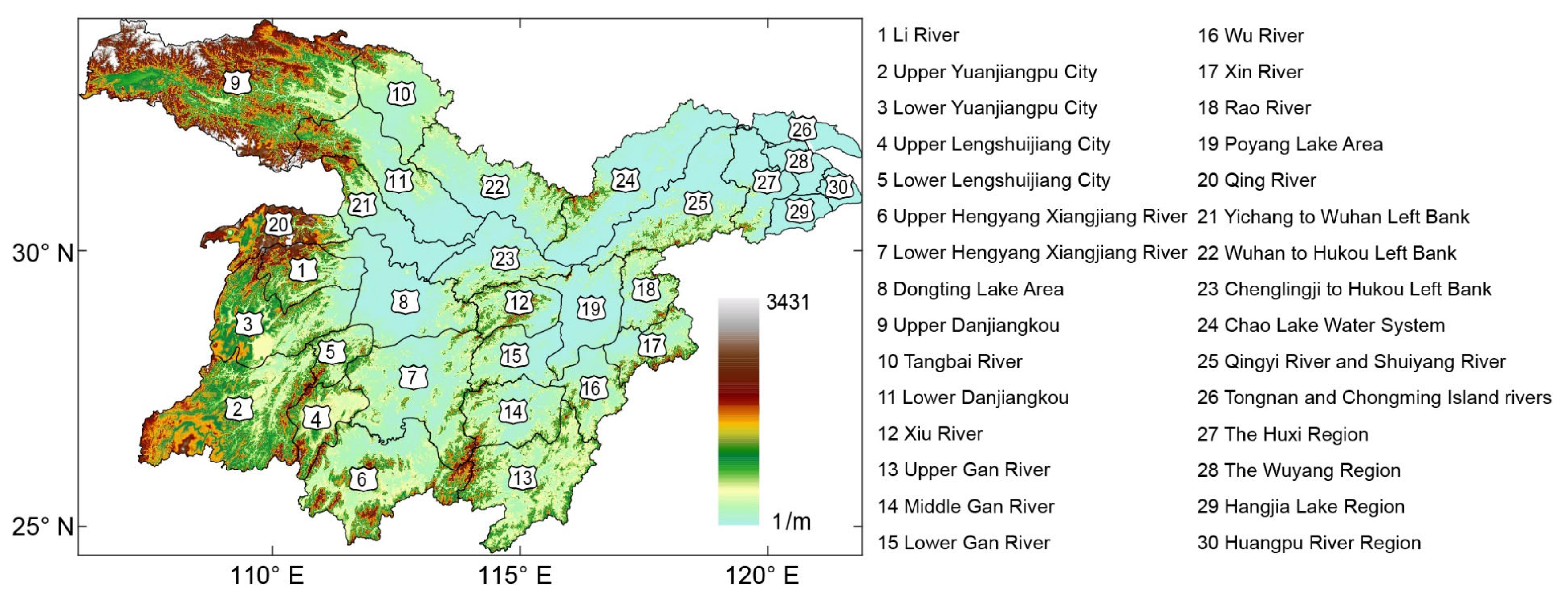


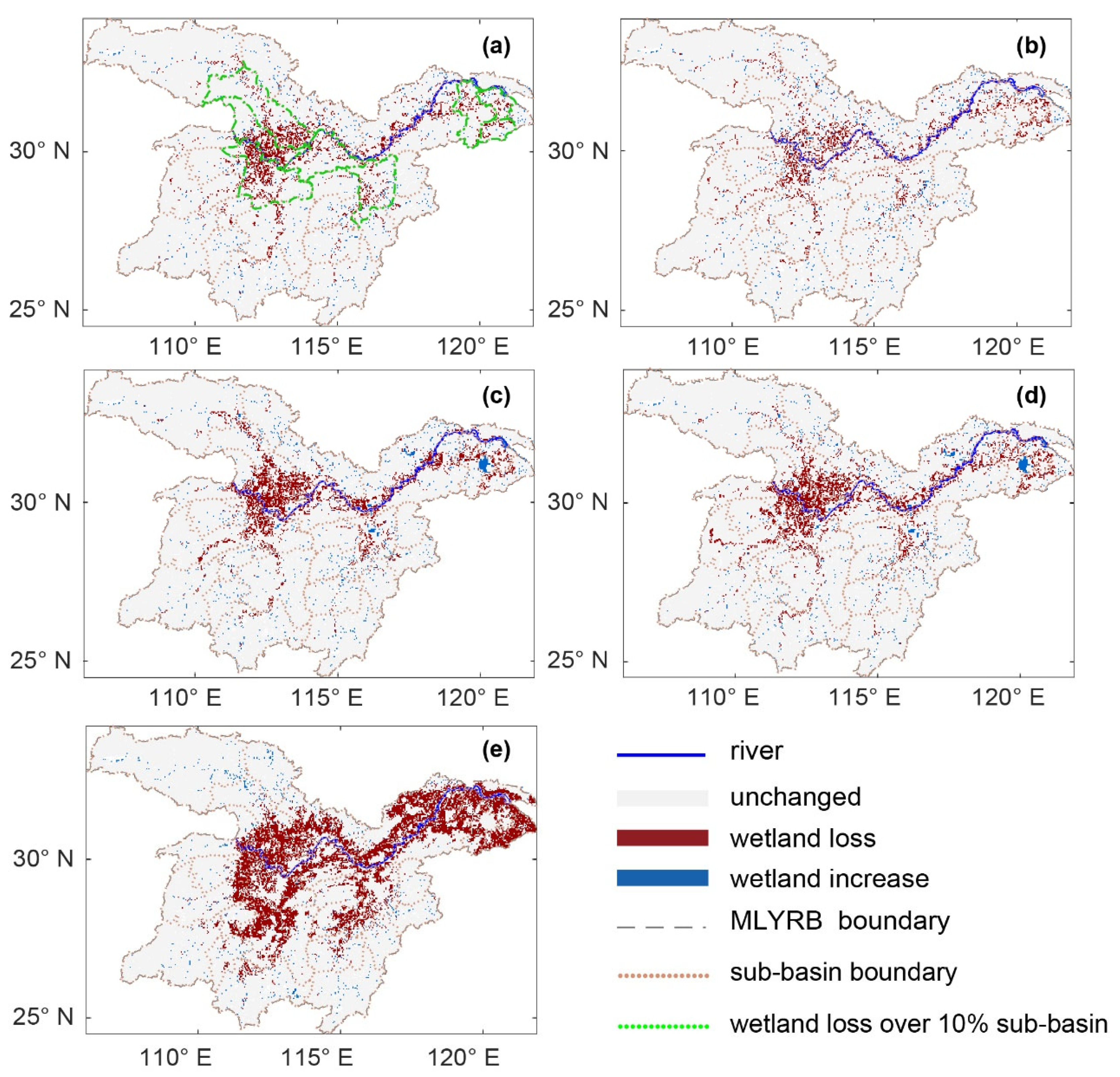
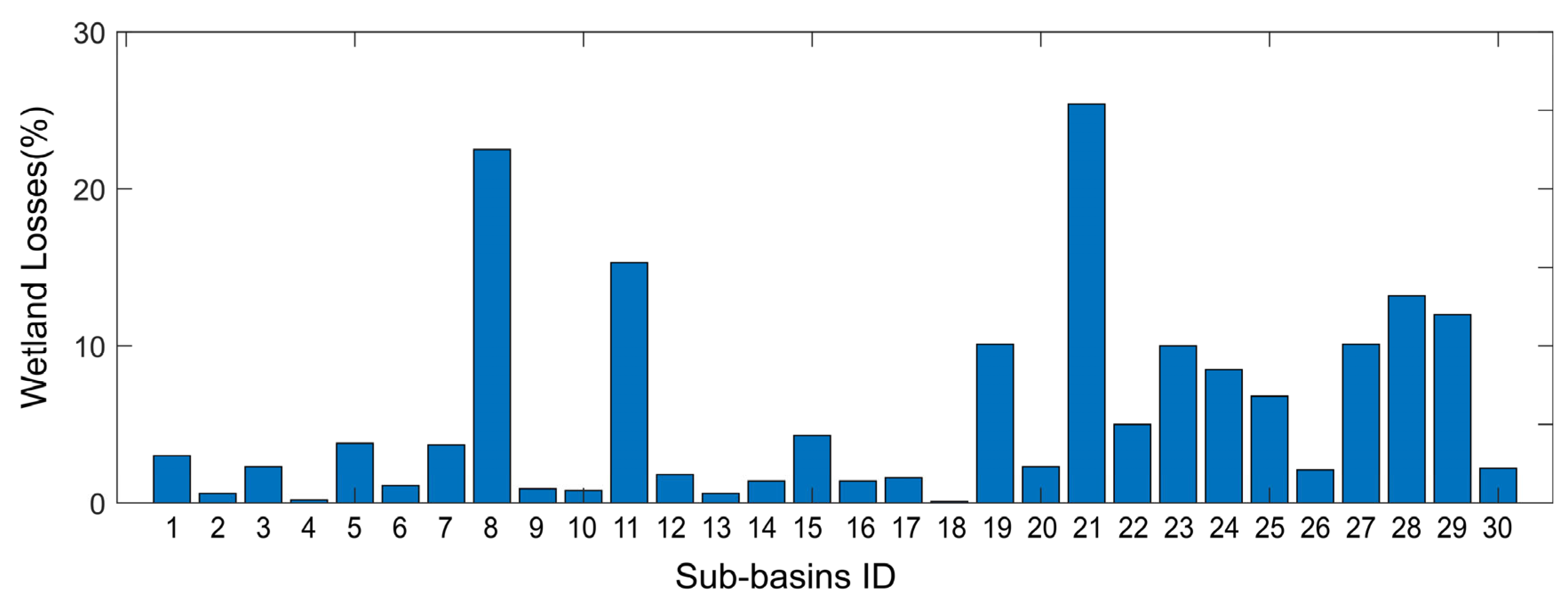
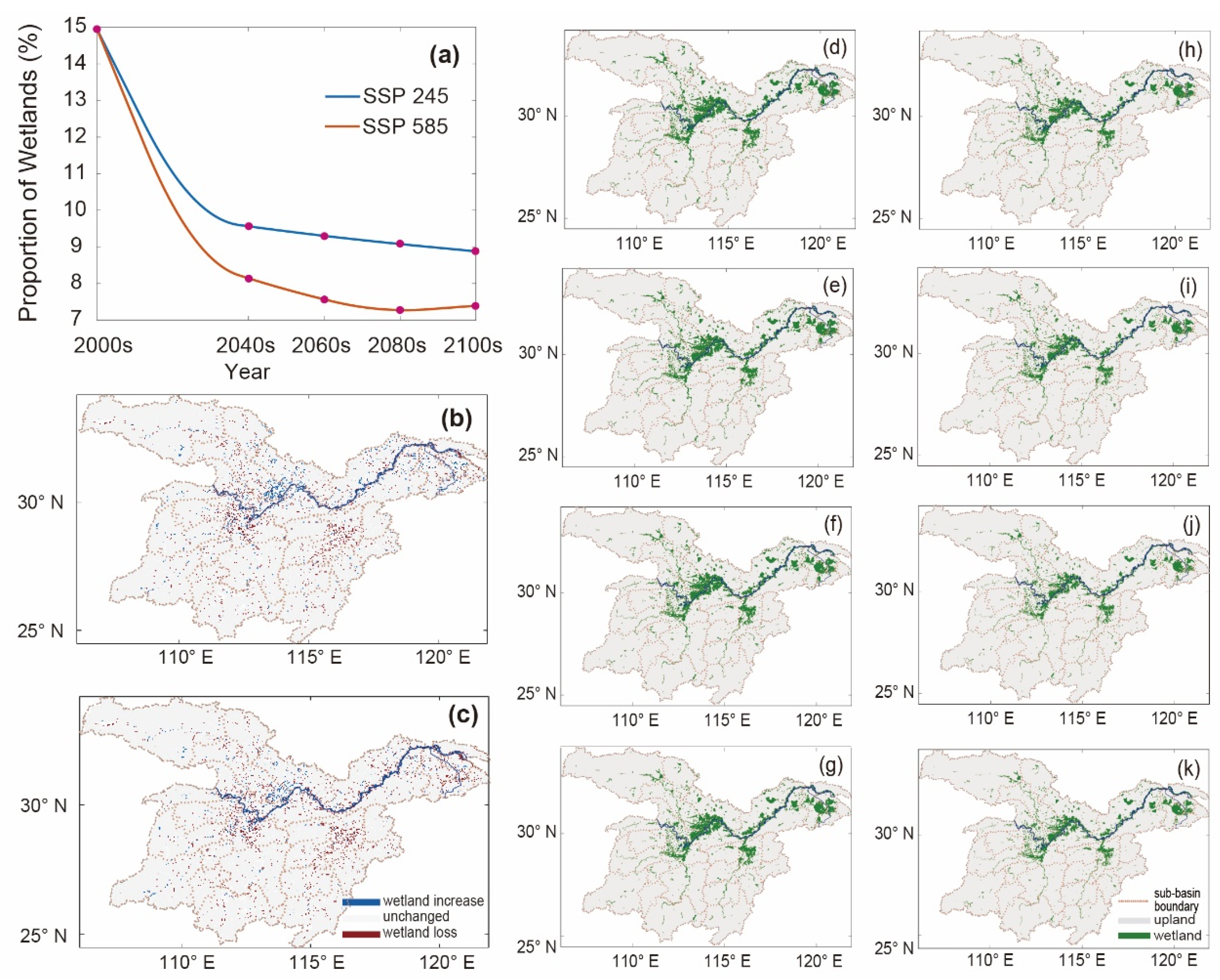
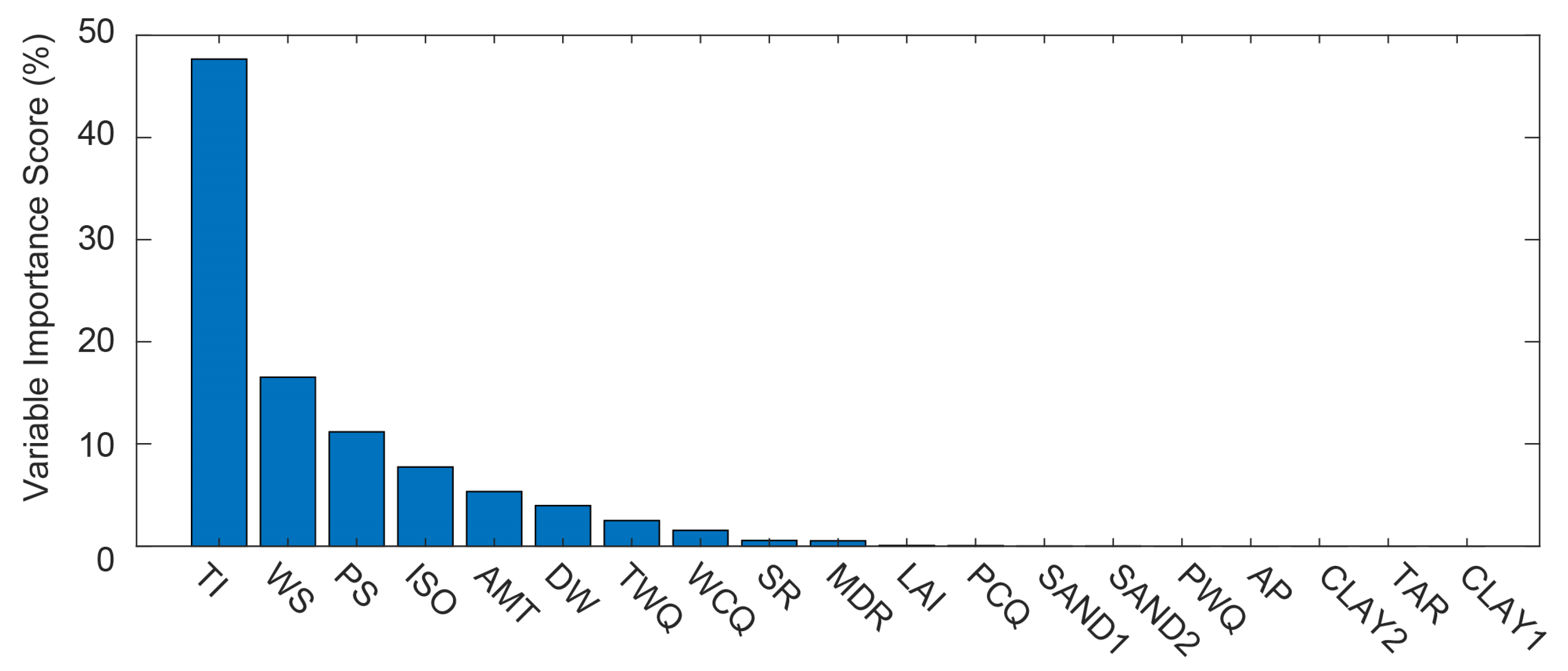
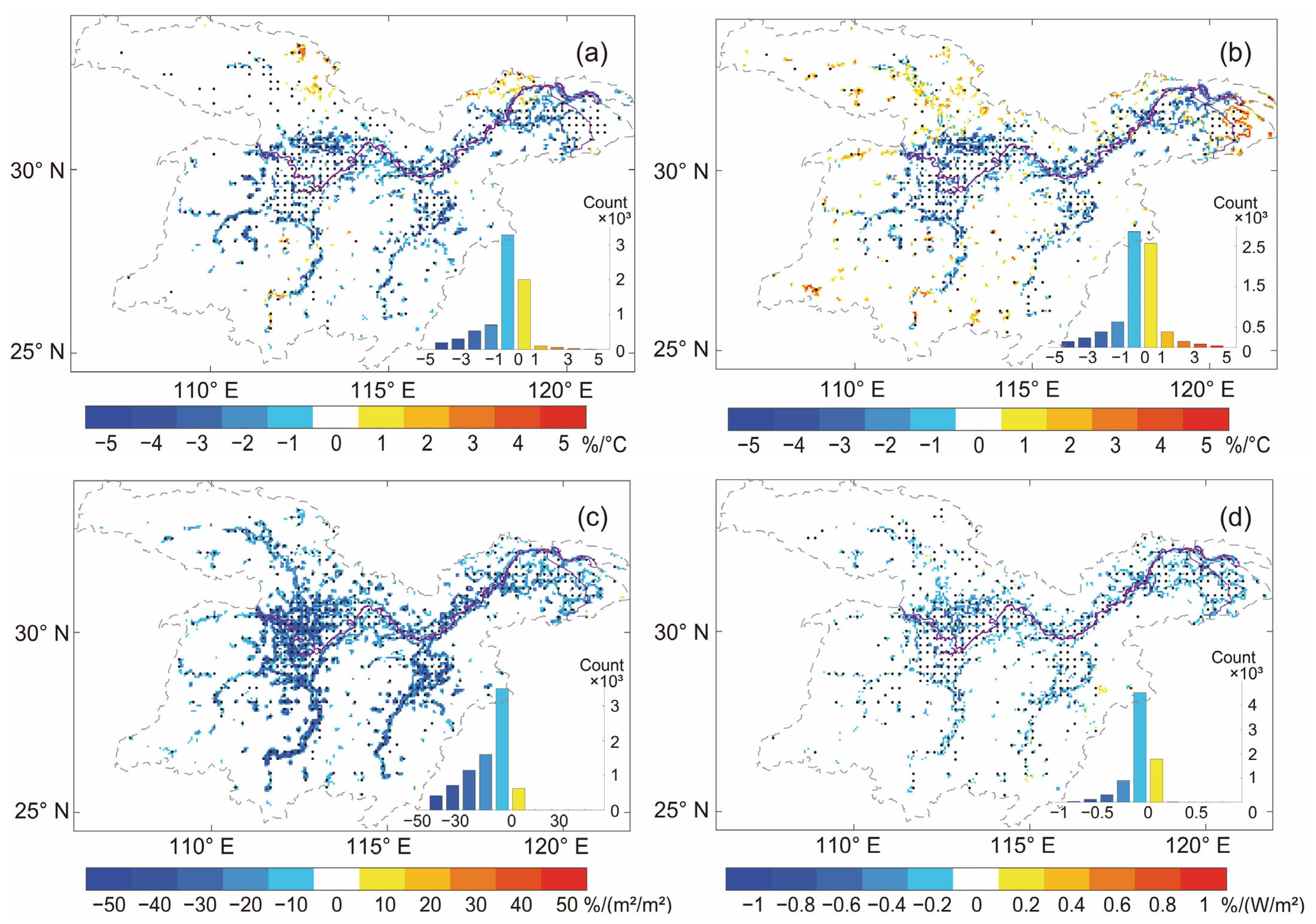
| Variables | Description | Abbreviation | Unit |
|---|---|---|---|
| V1 | Topographic wetness index | TI | - |
| V2 | Euclidean distance to water bodies | DW | m |
| V3 | Leaf area index | LAI | m2/m2 |
| V4 | Mean Annual wind speed | WS | m/s |
| V5 | Mean Annual solar radiation | SR | W/m2 |
| V6 | Soil sand content (0–30 cm) | SAND1 | % |
| V7 | Soil sand content (30–100 cm) | SAND2 | % |
| V8 | Soil clay content (0–30 cm) | CLAY1 | % |
| V9 | Soil clay content (30–100 cm) | CLAY2 | % |
| V10 | Mean Annual Temperature | MAT | °C |
| V11 | Mean Diurnal Range (Mean of monthly (max–min)) | MDR | °C |
| V12 | Isothermality | ISO | % |
| V13 | Temperature Annual Range | TAR | °C |
| V14 | Mean Temperature of Warmest Quarter | TWQ | °C |
| V15 | Mean Temperature of Coldest Quarter | TCQ | °C |
| V16 | Annual Precipitation | AP | mm |
| V17 | Precipitation Seasonality (Coefficient of Variation) | PS | - |
| V18 | Precipitation of Warmest Quarter | PWQ | mm |
| V19 | Precipitation of Coldest Quarter | PCQ | mm |
| Algorithm Name | Five-Fold Cross Validation Accuracy | Independent Verification Accuracy | Wetland Proportion | Wetland Losses Relative to Area of the Study Region | Wetland Losses Relative to Area of the Simulated Potential Wetlands |
|---|---|---|---|---|---|
| Adaptive Boosting tree | 97.5% | 94% | 14.9% | 6.3% | 42.3% |
| Random Forest | 97.1% | 95% | 13.2% | 4.6% | 35.0% |
| K-Nearest Neighbor | 97.5% | 80% | 15.0% | 6.4% | 42.8% |
| Artificial Neural Networks | 97.4% | 81% | 16.1% | 7.5% | 46.6% |
| Bayesian Classification | 89.0% | 93% | 28.6% | 20.1% | 69.9% |
| Name | Proportion of Wetland Losses |
|---|---|
| Dongting Lake Area | 22.5% |
| Lower Danjiangkou | 15.3% |
| Poyang Lake Area | 10.1% |
| Yichang to Wuhan Left Bank | 25.4% |
| Wuhan to Hukou Left Bank | 5.0% |
| Chenglingji to Hukou Left Bank | 10.0% |
| Chao Lake Water System | 8.5% |
| Qingyi River and Shuiyang River | 6.8% |
| The Huxi Region | 10.1% |
| Wuyang Region | 13.2% |
| Hangjia Lake Region | 12.0% |
| Variable Name | The Number of Grids That Passes the Significance Test (95%) | The Proportion That Passes the Significance Test |
|---|---|---|
| TCQ | 6224 | 82.7% |
| TWQ | 5657 | 72.3% |
| LAI | 8164 | 96.5% |
| SR | 7100 | 92.3% |
Disclaimer/Publisher’s Note: The statements, opinions and data contained in all publications are solely those of the individual author(s) and contributor(s) and not of MDPI and/or the editor(s). MDPI and/or the editor(s) disclaim responsibility for any injury to people or property resulting from any ideas, methods, instructions or products referred to in the content. |
© 2023 by the authors. Licensee MDPI, Basel, Switzerland. This article is an open access article distributed under the terms and conditions of the Creative Commons Attribution (CC BY) license (https://creativecommons.org/licenses/by/4.0/).
Share and Cite
Ma, Z.; Chen, W.; Xiao, A.; Zhang, R. The Susceptibility of Wetland Areas in the Yangtze River Basin to Temperature and Vegetation Changes. Remote Sens. 2023, 15, 4534. https://doi.org/10.3390/rs15184534
Ma Z, Chen W, Xiao A, Zhang R. The Susceptibility of Wetland Areas in the Yangtze River Basin to Temperature and Vegetation Changes. Remote Sensing. 2023; 15(18):4534. https://doi.org/10.3390/rs15184534
Chicago/Turabian StyleMa, Zhenru, Weizhe Chen, Anguo Xiao, and Rui Zhang. 2023. "The Susceptibility of Wetland Areas in the Yangtze River Basin to Temperature and Vegetation Changes" Remote Sensing 15, no. 18: 4534. https://doi.org/10.3390/rs15184534
APA StyleMa, Z., Chen, W., Xiao, A., & Zhang, R. (2023). The Susceptibility of Wetland Areas in the Yangtze River Basin to Temperature and Vegetation Changes. Remote Sensing, 15(18), 4534. https://doi.org/10.3390/rs15184534






